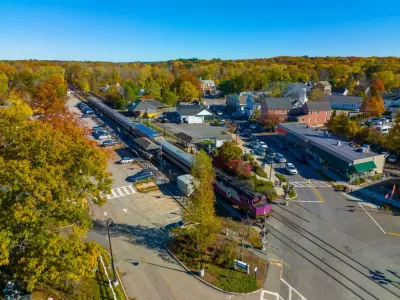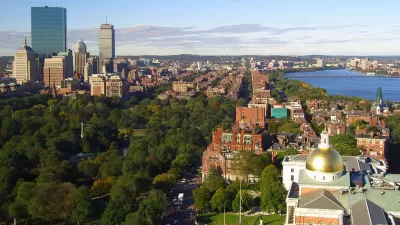Cities and towns had until January 31 to submit their draft plans for rezoning areas near transit stations to comply with a new state law.

According to an article by Christian MilNeil in Streetsblog Mass, 175 Massachusetts municipalities had until yesterday to submit plans complying with the state’s new transit-oriented development (TOD) law, which requires them to submit non-binding ‘action plans’ identifying proposals for legalizing multifamily zoning to support increased housing production near transit stations.
“Where many suburbs currently only allow single-family homes with large lawns, the new rules will require new zoning districts ‘of reasonable size,’ and generally within a half-mile of transit stops, where builders would be allowed to construct at least 15 homes per acre,” MilNeil explains. Noncompliance would bar cities and towns from receiving certain state funding.
As many housing advocates point out, zoning reform is just the first step toward more housing production, and market conditions and other factors will also dictate where and how much housing gets built. In the Town of Weston, one of the “exclusionary suburbs” required to submit a plan, members of the town’s Housing Production Plan Implementation Committee “raised the point that simply creating a new zoning law to comply with the new state rules need not necessarily lead to more housing on the ground.”
An article from last September expressed concerns that the service disruptions and other problems experienced by the Massachusetts Bay Transportation Authority (MBTA) in the last few years could hinder TOD, but advocates remain hopeful that the agency will make the necessary improvements to effectively serve the region.
FULL STORY: Suburbs Face Their First Deadline for New Transit-Oriented Zoning Law

Alabama: Trump Terminates Settlements for Black Communities Harmed By Raw Sewage
Trump deemed the landmark civil rights agreement “illegal DEI and environmental justice policy.”

Planetizen Federal Action Tracker
A weekly monitor of how Trump’s orders and actions are impacting planners and planning in America.

The 120 Year Old Tiny Home Villages That Sheltered San Francisco’s Earthquake Refugees
More than a century ago, San Francisco mobilized to house thousands of residents displaced by the 1906 earthquake. Could their strategy offer a model for the present?

Opinion: California’s SB 79 Would Improve Housing Affordability and Transit Access
A proposed bill would legalize transit-oriented development statewide.

Record Temperatures Prompt Push for Environmental Justice Bills
Nevada legislators are proposing laws that would mandate heat mitigation measures to protect residents from the impacts of extreme heat.

Downtown Pittsburgh Set to Gain 1,300 New Housing Units
Pittsburgh’s office buildings, many of which date back to the early 20th century, are prime candidates for conversion to housing.
Urban Design for Planners 1: Software Tools
This six-course series explores essential urban design concepts using open source software and equips planners with the tools they need to participate fully in the urban design process.
Planning for Universal Design
Learn the tools for implementing Universal Design in planning regulations.
Clanton & Associates, Inc.
Jessamine County Fiscal Court
Institute for Housing and Urban Development Studies (IHS)
City of Grandview
Harvard GSD Executive Education
Toledo-Lucas County Plan Commissions
Salt Lake City
NYU Wagner Graduate School of Public Service





























